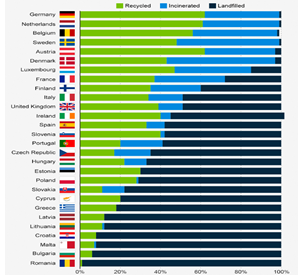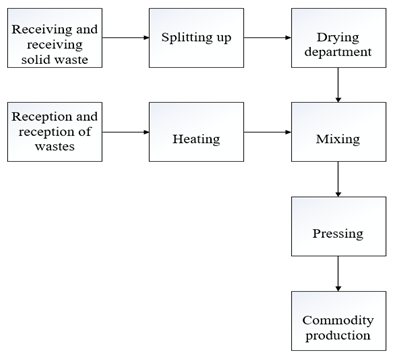Аннотация
Kurchenko E.N., Kalinihin O.N., Boyko V.N. Co-disposal of waste from coke plants and municipal solid waste components. The article analyzes difficult situation in the field of solid household and industrial waste disposal over the past three years. Features of the implementation of the production of RDF fuel based on household waste components and bottoms are described.
The choice of research topics is associated with exacerbation of economic, environmental and social problems due to an increase in the volume of produced and utilized solid waste and industrial wastes, the need to search for and introduce more advanced, environmentally and economically sound waste disposal plants.
Currently, there are huge accumulations of municipal solid waste (MSW) in Donetsk region, because there are no fully-fledged effective methods of waste disposal and recycling.
In 2018, 750539.468 tons of hazard class IV wastes were generated, 99.1% of which is disposed in specially designated places and facilities. The rest of the waste is disposed in unorganized storage areas. Wastes of the IV hazard class make up 99.95% of the annual volume of waste of all hazard classes.
Today, one of the main tasks relevant worldwide is the processing and disposal of municipal and industrial waste. Waste management statistics in Europe are shown in Figure 1 [1].

Figure 1 – Household waste treatment in the countries of the European Union
Figures released by Eurostat have revealed the enormous gulf between countries in the western and eastern halves of the European Union when it comes to recycling. Germany is leading the way, recycling 62 percent of its waste, incinerating 37 percent and landfilling just one percent.
The Netherlands comes a close second with the same level of landfill and 61 and 38 percent levels of recycling and incineration respectively. Belgium rounds off the top three, recycling 56 percent of its waste.
Sweden, which has been making headlines recently regarding the efficiency of its waste to energy programme, comes fourth. Even though the figures show Sweden as landfilling one percent of its waste, it has emerged that the country is actually importing 800,000 tons of rubbish to power its waste to energy plants – burned waste powers approximately 250,000 Swedish homes.
Unfortunately, Sweden’s excellent example shows no signs of being repeated in Eastern Europe where the level of landfill rises dramatically. Croatia, the EU’s newest member, is the fourth worst offender for recycling - 92 percent of Croatian trash ends up in landfill, while eight percent is recycled.
The accumulation and untimely removal of waste creates an environmental hazard to public health due to the content of a large amount of organic substances in them, which form harmful chemical compounds when decomposed.
Energy recovery from waste is the conversion of non-recyclable waste materials into usable heat, electricity or fuel through a variety of processes, including combustion, gasification, pyrolisis, anaerobic digestion and landfill gas recovery. This process is often called energy waste.
MSW can be considered as a strategic resource for generating heat and electricity.
European countries are moving away from the practice of burning household waste, replacing this method with modern resource and energy-saving technologies, alternative energy sources and the reuse of raw materials, which acts as a method of resources saving and the environment preservation.
Refuse Derived Fuel (RDF) is one of such technologies when the fuel is produced from various types of waste, such as municipal solid waste and industrial waste. The main consumers of this fuel are the cement industry, power stations and heating plants [2].
Considering the morphological composition of solid waste, about 25% of the volume of waste transported to landfill can be involved in the production of RDF fuel. The advantages are that the amount of waste disposed and the consumption of exported energy sources are reduced.
Table 1 shows the indicators of the components of municipal solid waste in Donetsk region, which are of interest as components of RDF fuel [4].
Table 1 – Indicators of waste fractions in MSW

The caloric content of fuel depends on the amount of combustible fractions in MSW; therefore, it is reasonably to add components with high calorific value to the waste. As such a component, tarry wastes of coke-chemical wastes (CCP), such as coal fusas, polymers, bottoms, etc. can be used.
Let us consider still bottoms of the crude benzene rectification workshop as an additive to fuel briquettes based on solid waste components. They are a suitable waste due to their low ash content with a small amount of sulfur, the value of which is quite high in fossil fuel.
Abroad still bottoms of rectification are pyrolyzed in the presence of water vapor and hydrogen, followed by catalytic dehydrogenation of the gaseous pyrolysis products. Binding residues are obtained from still bottoms. Binding residues are used to form binders for the manufacture of anti-corrosion dyes, cladding plates and other building materials.
The bottoms of the crude benzene rectification workshop are a mixture of products of different polymerization depths of unsaturated compounds with benzene hydrocarbons, thiophene and its homologues, as well as aromatic hydrocarbons with a boiling point above 200 °C, extracted from absorption oil while crude benzene production. In addition, they contain mineral impurities, which are a mixture of sodium sulfate (3.7%), free alkali (0.1%) and sodium sulfonates (14.5%) formed during alkaline neutralization of the fraction after acid washing [3].
Alternative fuel, based on the components of solid waste and bottoms of the crude benzene rectification workshop at coke plants, can be used as a more affordable fuel in terms of price policy, which is not inferior in terms of technical characteristics to brown and hard coal.
The technological process of obtaining RDF consists of two operations: waste crushing and separation of ferrous metals, but if we are limited to only these two operations, the RDF obtained in this case will contain many ballast fractions and be of low quality.
Therefore, additional machines, mechanisms and assemblies are used in the production of granular fuel, that allow enriching, granulating and briquetting fuel from waste, while increasing investment and operating costs, but the resulting fuel has significantly better quality. Schematic diagram of the production of granular fuel is shown in Figure 2.
The method of producing RDF fuel depends on the type of waste, its composition, as well as the subsequent method of use as the main or additional (together with the main - coal, peat, etc.) fuel [4]. The heat of combustion of granular fuel varies 5300 - 17700 kJ / kg.
Many boiler plants need only a little modernization to work on granular fuel, because they are equipped with devices for removing slag and fly ash.

Figure 2 - The main stages of the production of RDF fuel
Modern thermal processes are environmentally friendly during the heat treatment of prepared solid waste, in accordance with technological standards and using modern gas cleaning methods (in turn, the efficiency of gas cleaning is largely determined by the implementation of the so-called primary measures in the thermal process). In this case, according to German practice, industrial emissions are well below the limits regulated by strict environmental legislation [5].
As can be seen from the above, it can be concluded that the use of a binder based on bottoms will significantly reduce the cost of briquettes while maintenance their operational qualities. Due to the co-disposal of solid waste and coke plants waste, they become the category of commercial products.
References
1. Recycling Remains a Rarity in Eastern Europe
2. Зарубежная практика использования альтернативного топлива из отходов для цементной промышленности/ И.В. Ламзина, В.Ф. Желтобрюхов, И.Г. Шайхиев // Вестн. технолог.ун-та. Т.18, №17. – 2015. – C. 85-88.
3. Лазорин С.Н. Обезвреживание отходов коксохимических заводов/ С.Н. Лазорин, Т.И. Паннов, В.И.Литвиненко.– М.: Металлургия, 1977. – 239 с.
4. Сметанин В. И. Защита окружающей среды от отходов производства и потребления: Учебники и учеб. пособия для студентов высш. учеб. заведений. – М.: Колос, 2000. – 232 с.
5. Термическая переработка ТБО
Аннотация. В статье проанализирована ситуация сложившаяся в сфере утилизации твердых бытовых и промышленных отходов за последние 3 года. Описаны особенности реализации производства RDF-топлива на основе компонентов твердых бытовых отходов и кубовых остатков.
Сведения об авторах:
Курченко Елена Николаевна – ст.гр. ИЗОСм-19, ДонНТУ
Калинихин Олег Николаевич – к.т.н., доцент, кафедра «Прикладная экология и охрана окружающей среды», ДонНТУ
Бойко Виктория Николаевна – ст. преподаватель кафедры английского языка, ДонНТУ